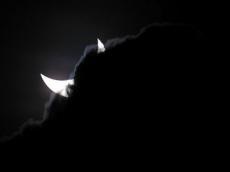|
|
TODAY.AZ / Weird / Interesting
Worls observes total solar eclipse - PHOTOS - VIDEO
14 November 2012 [11:30] - TODAY.AZ
 A total solar eclipse occurred over the northeastern Australian coast early in the morning of November 14 local time.
A total solar eclipse occurred over the northeastern Australian coast early in the morning of November 14 local time.Clueless about this spectacular astronomical event? No worries, we've got you covered. We're here to explain what causes this remarkable act of nature, what skygazers see and how those outside of Australia can join in the experience.
What exactly is a total solar eclipse?
A solar eclipse happens when the moon, as it orbits Earth, passes directly in front of the sun, obscuring its rays and casting a shadow on Earth's surface. Sometimes referred to as a "happy accident of nature," a total solar eclipse occurs when the moon is perfectly aligned with both the sun and Earth, so it appears from our perspective that the sun is completely blocked.
When is this happening and who can see it?
The total solar eclipse became visible in the far north of Australia about an hour after sunrise local time on November 14 (afternoon of November 13 in the United States and evening of November 13 in Europe).
A total eclipse of the sun can only be seen from within what's known as the path of totality, a narrow path the moon's inner shadow travels as it glides across the Earth. The most populated areas within that path are in the Cairns and Great Barrier Reef region.
moon's shadow to travel the entire path of totality. What time total darkness occurred, and how long it lasted, depended on location. Totality was expected to begin in Cairns at 0638 local time and was to last nearly two minutes. By contrast, totality was estimated to only last just about 20 seconds in the small town of Innisfail.
URL: http://www.today.az/news/interesting/115130.html
 Print version
Print version
Views: 2090
Connect with us. Get latest news and updates.
See Also
- 19 February 2025 [22:20]
Visa and Mastercard can return to Russia, but with restrictions - 05 February 2025 [19:41]
Japan plans to negotiate with Trump to increase LNG imports from United States - 23 January 2025 [23:20]
Dubai once again named cleanest city in the world - 06 December 2024 [22:20]
Are scented candles harmful to health? - 23 November 2024 [14:11]
Magnitude 4.5 earthquake hits Azerbaijan's Lachin - 20 November 2024 [23:30]
Launch vehicle with prototype of Starship made its sixth test flight - 27 October 2024 [09:00]
Fuel prices expected to rise in Sweden - 24 October 2024 [19:14]
Turkiye strikes terror targets in Iraq and Syria - 23 October 2024 [23:46]
Kazakhstan supplied almost entire volume of oil planned for 2024 to Germany in 9 months - 23 October 2024 [22:17]
Taiwan reported passage of Chinese Navy aircraft carrier near island
Most Popular
 Armenian passion for Kazakh wheat
Armenian passion for Kazakh wheat
 Brazil launches Amazon transport alliance
Brazil launches Amazon transport alliance
 Azerbaijani literature section opens at Albanian National Library
Azerbaijani literature section opens at Albanian National Library
 ANCA has made another attempt to put pressure on Trump: The Theater of the absurd
ANCA has made another attempt to put pressure on Trump: The Theater of the absurd
 Kazakhstan proposes age limits for social media
Kazakhstan proposes age limits for social media
 President Ilham Aliyev dismisses head of Goygol District Executive Power
President Ilham Aliyev dismisses head of Goygol District Executive Power
 Azerbaijani companies participate in Turkmentel-2025 International Exhibition in Ashgabat
Azerbaijani companies participate in Turkmentel-2025 International Exhibition in Ashgabat





























